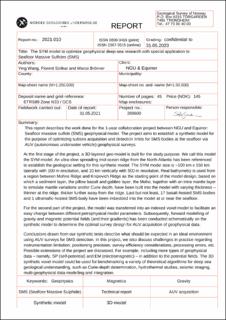| dc.description.abstract | This report describes the work done for the 1-year collaboration project between NGU and Equinor: Seafloor massive sulfide (SMS) geophysical model. The project aims to establish a synthetic model for the purpose of optimizing subsea acquisition and detection limits for SMS bodies at the seafloor via AUV (autonomous underwater vehicle) geophysical surveys. At the first stage of the project, a 3D layered geo-model is built for the study purpose. We call this model the SYM model. An ultra-slow spreading mid-ocean ridge from the North Atlantic has been referenced to establish the geological setting for this synthetic model. The SYM model size is ~100 km x 150 km laterally with 100 m resolution, and 10 km vertically with 500 m resolution. Real bathymetry is used from a region between Mohns Ridge and Knipovich Ridge as the starting point of the model design, based on which a sediment layer, the pillow basalt and gabbro layer, the Moho, together with an intra mantle layer to simulate mantle variations and/or Curie depth, have been built into the model with varying thickness – thinner at the ridge, thicker further away from the ridge. Last but not least, 17 basalt-hosted SMS bodies and 1 ultramafic-hosted SMS body have been imbedded into the model at or near the seafloor. For the second part of the project, the model was transferred into an indexed voxel model to facilitate an easy change between different petrophysical model parameters. Subsequently, forward modelling of gravity and magnetic potential fields (and their gradients) has been conducted schematically on the synthetic model to determine the optimal survey design for AUV acquisition of geophysical data. Conclusions drawn from our synthetic tests describe what should be expected in an ideal environment using AUV surveys for SMS detection. In this project, we also discuss challenges in practice regarding instrumentation limitation, positioning precision, survey efficiency considerations, processing errors, etc. Possible extensions of the project are discussed. For example, including more types of geophysical data – namely, SP (self-potential) and EM (electromagnetic) – in addition to the potential fields. The 3D synthetic voxel model could be used for benchmarking a variety of theoretical algorithms for deep sea geological understanding, such as Curie-depth determination, hydrothermal studies, seismic imaging, multi-geophysical data modelling and integration | |

